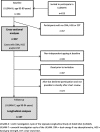The impact of muscle function, muscle mass and sarcopenia on independent ageing in very old Swedish men
- PMID: 31142271
- PMCID: PMC6542054
- DOI: 10.1186/s12877-019-1142-y
The impact of muscle function, muscle mass and sarcopenia on independent ageing in very old Swedish men
Abstract
Background: Preserved functions of daily life and cognition are cornerstones of independent aging, which is crucial for maintaining a high quality of life. The aim of this study was to examine the impact of sarcopenia, and its underlying components, on independent ageing in a cohort study of very old men.
Methods: The presence of sarcopenia and independent ageing at a mean age of 87 was investigated in 287 men from the Uppsala Longitudinal Study of Adult Men. Five years later 127 men were re-evaluated for independent ageing. Sarcopenia was defined by two different definitions from the European Working Group on Sarcopenia in Older People. In the first definition sarcopenia was defined as skeletal muscle index < 7.26 kg/m2 and either gait speed ≤0.8 m/s or hand grip strength < 30 kg. In the later up-dated definition, HGS < 27 kg and/or chair stand test > 15 s defines probable sarcopenia, which is confirmed by SMI < 7.0 kg/m2. Independent ageing was defined as a Mini-Mental State Examination score of ≥25 points, absence of diagnosed dementia, community-dwelling, independency in personal care and ability to walk outdoors alone.
Results: Sarcopenia at baseline was observed in 21% (60/287) and 20% (58/287), respectively, due to definition. The prevalence of independent ageing was 83% (239/288) at baseline and 69% (87/127) five years later. None of the sarcopenia diagnoses were associated with independent ageing. In contrast, gait speed was both in cross-sectional (odds ratio (OR) per one standard deviation increase 2.15, 95% confidence interval (CI) 1.47-3.15), and in longitudinal multivariate analyses (OR 1.84, 95% CI 1.19-2.82). In the cross-sectional analysis also higher hand grip strength was associated with independent ageing (OR 1.58, 95% CI 1.12-2.22), while a slower chair stand test was inversely associated (OR 0.61, 95% CI 0.43-0.86). Muscle mass; i.e. skeletal muscle index, was not associated with independent ageing.
Conclusions: For very old men, especially a higher gait speed, but also a higher hand grip strength and a faster chair stand test, were associated with independent ageing, while skeletal muscle index alone, and the composite sarcopenia phenotype measured with two different definitions, were not.
Keywords: Chair stand test; EWGSOP1; EWGSOP2; Gait speed; Hand grip strength; Independent ageing; Muscle function; Muscle mass; Sarcopenia.
Conflict of interest statement
TC has received unconditional research grants from Nutricia, Nestlé and Fresenius-Kabi, and is giving lectures arranged by Nutricia, Nestlé, Fresenius-Kabi and Abbott. KF, BZ and LK have no competing interests to declare.
Figures
References
Publication types
MeSH terms
LinkOut - more resources
Full Text Sources
Medical


